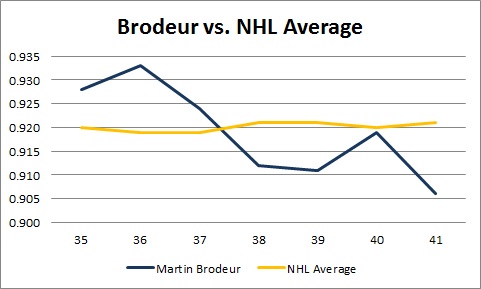Last week, the St. Louis Blues signed future Hockey Hall of Famer Martin Brodeur to a bonus-laden one-year contract—he earned $20,000 for his win Saturday. The interesting point wasn’t so much that Brodeur had found a major-league job, but rather in the Blues’ handling of the signing.
The team treated the addition of Brodeur not as the quiet add of a veteran backup, but rather as the coronation of a new starter. Head coach Ken Hitchcock told the Blues’ official website that Brodeur would play if he was on the roster, that “he’s not going to back up.” That same website was reworked so that anyone going to stlouisblues.com first landed on a full-page “Welcome Marty” graphic.
It’s an interesting tack for the team to take. While Brodeur’s career obviously commands tremendous respect, it isn’t at all clear that his current level of ability deserves an NHL contract, let alone the level of fanfare the Blues lavished on him. There really isn’t much history of goalies contributing meaningful games as they get into their 40s; even Hall of Famers aren’t immune to the ravages of time.
Some of the game’s most legendary goalies played into their 40s, and it didn’t always go well. George Hainsworth, the three-time Vezina winner who is sometimes characterized as the best goalie in league history, played all 48 of his team’s games at the age of 40, posting a 2.12 goals-against average. The next year, his numbers ballooned and Toronto released him; he had a brief cameo in Montreal and then retired. The experience was similar for players like Johnny Bower and Gump Worsley, both of whom played into their 40s before rapid declines took them out of the game.
That experience isn’t unique to eras gone by, either. Nikolai Khabibulin was reasonably competent in three of four injury-plagued seasons in Edmonton, and Chicago took a chance on the 41-year-old last season. He lasted all of four games before injury and wretched play ended his career. The late-blooming Dwayne Roloson played 54 games at the age of 41, posting a .914 save percentage and looking like a legitimate starter for both the Islanders and the Lightning. He helped carry Tampa Bay all the way to the Conference final where the club bowed out in seven games to the eventual Cup-winning Bruins. The Lightning gave him a one-year extension and at age 42 he collapsed, posting an .886 save percentage and almost certainly costing his team a playoff spot in the process.
There are plenty of other examples of players experiencing a sudden and devastating drop-off in performance at about the same age as Brodeur is now. It’s a list that includes 2010 Olympic teammate Curtis Joseph, fellow Vezina winners Tony Esposito and Tim Thomas and New Jersey teammate Johan Hedberg. All still looked like solid NHL goalies into at least their late 30s; all of them suddenly crashed and burned around age 40.
But it’s also necessary to look at Brodeur’s own career track record, because it isn’t a given that he’s going to struggle just because he’s 42 years old. We know that because two of the players often mentioned with Brodeur in the ‘best goalie of all-time’ conversation fared pretty well at 42. Dominik Hasek was still starting for Detroit, and he got both Vezina and Hart Trophy votes that season. Jacques Plante was even better at 42, being named a second-team all-star and placing fifth in voting for NHL MVP on the back of an incredible .944 save percentage. That’s why it’s worth looking at Brodeur’s career in more detail.
If we are to expect Brodeur to defy history the way that Hasek and Plante did, we need to see that in his recent performance. At 40, Plante won the Vezina in St. Louis. At 41, Hasek posted a .925 save percentage in a league in which the average in all situations was .901. Both had recently shown an ability not just to play in the NHL but to be dominant at their position. Unfortunately for St. Louis, the same is not true for Brodeur, which is obvious when we compare his save percentage at even-strength to the league-average:

Brodeur was still great in his mid-30s, clearly outpacing the league. He won a Vezina at 35 and even at 37 was still above the league average. But that’s half a decade in the rearview mirror at this point; the only time in the past four seasons he’s even flirted with the NHL average was during the lockout-shortened 2012-13 campaign.
Some see the Brodeur signing as St. Louis making a low-risk wager on one of the all-time greats. That’s true to a degree, but that framing misses the point, because it’s been years since Martin Brodeur on the ice looked anything like the Martin Brodeur who inhabits the NHL record books. Instead, the Blues are gambling on a player who combines the recent track record of an unspectacular backup with the sudden collapse risk of a 42-year-old.
If Brodeur manages to hold off Father Time for another year, St. Louis will have an unmemorable No. 2; if he doesn’t they’ll have something considerably south of that.

